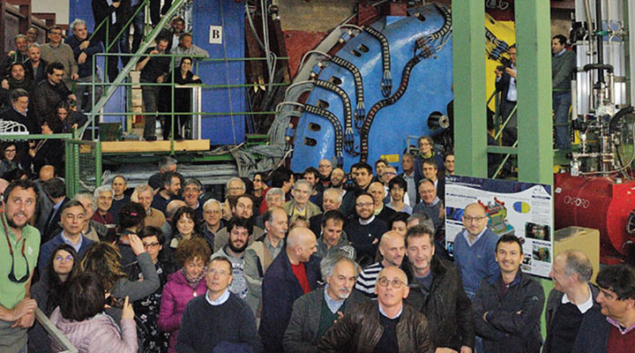

On 30 March the KLOE-2 experiment concluded its data-taking campaign at the electron–positron collider DAΦNE at the INFN National Laboratory of Frascati (LNF), Italy. This marks the conclusion of a two-decades long period of activity at the Frascati lab, which began with the first data collected by KLOE in 1999 and then continued with KLOE-2 since November 2014. In total, an integrated luminosity of around 8 fb−1 (corresponding to around 24 billion φ-mesons) was acquired, representing the largest ever sample collected at the φ-resonance peak.
In terms of machine physics, the KLOE/DAΦNE programme has brought a wealth of results and a few world firsts. The KLOE-2 run saw the first application of the “crab-waist” concept – an interaction scheme developed in Frascati with the transverse dimensions of the beams and their crossing angle tuned to maximise the machine luminosity – in the presence of a high-field detector solenoid. The implementation of this innovative configuration by the DAΦNE team allowed KLOE-2 to collect an integrated luminosity of 5.5 fb−1 in a period of just over three years.
Record performances in terms of peak luminosity (2.4 × 1032 cm–2 s–1) and maximum daily integrated luminosity (14 pb–1/day) have been achieved for an electron–positron collider running at such centre-of-mass energies (approximately 1 GeV).
The general-purpose KLOE detector, comprising a 4 m-diameter drift chamber surrounded by a lead-scintillating-fibre electromagnetic calorimeter with very good energy and timing performance at low energies, underwent several upgrades including a cylindrical gas-electron-multiplier (GEM) detector for the inner tracker. To improve its vertex reconstruction capabilities near the interaction region, KLOE-2 was the first high-energy experiment using GEM technology with a cylindrical geometry – a novel idea that was developed at LNF.
Together with its predecessor KLOE, the KLOE-2 data sample is rich in physics. The analysis of KLOE data provided, and continues to provide, a variety of significant results on: neutral and charged kaon properties; tests of discrete symmetries; tests of the unitary of the quark mixing matrix; light-scalar-meson spectroscopy; η-meson decays; hadronic cross sections and the anomalous magnetic moment (g-2) of the muon; and searches for dark photons.
Analyses of the KLOE-2 data is ongoing, in particular extending the KLOE physics programme in precision tests of fundamental discrete symmetries and the quantum coherence of entangled neutral kaon pairs. The roughly 60-strong collaboration will also study rare KS and η-meson decays and strong interactions in low-energy processes, in addition to γγ physics and the search for possible manifestations of dark matter.
Overall, the KLOE programme has involved hundreds of Italian and foreign physicists in a challenging human and scientific enterprise. But activities at the DAΦNE accelerator complex do not stop here. They are now continuing with the PADME and Siddharta-2 experiments, designed to search for dark photons and to study exotic atoms and strong interactions at low energies, respectively. Frascati Laboratory is also planning to revamp the DAΦNE complex, becoming a world-class test facility for R&D in accelerator physics, and is applying to host the future EuPRAXIA infrastructure for a European plasma-based free-electron Laser.
“The KLOE experiment has been a scientific milestone for the laboratory and for particle physics,” says LNF director, Pierluigi Campana. “DAΦNE will continue to produce physics for PADME and Siddharta-2, and we are thinking towards its future after 2020.”





